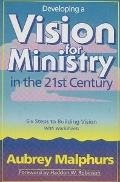Developing a Vision for Ministry in the 21st Century. By Aubrey Malphurs. Grand Rapids: Baker Book House, 1992. 256 pp. Paper, $11.95.

Two books have appeared this year which will be a source of great help to pastors or to anyone who leads a Christian organization. Both books address the important issue of developing a vision for one’s church or ministry. Barna is a well-known Christian figure. As head of the Barna Research Group, he has been addressing societal change and the corresponding need for church change in books like The Frog in the Kettle and User Friendly Churches. His book on vision draws from the data he has collected in his interaction with churches.
Malphurs is Chairman of the Field Education Department at Dallas Theological Seminary, where he also teaches courses on church planting and church growth. His book relies more on in-depth research and personal experience.
These two books are similar in that both convince the reader of the practical necessity of having a vision for the local church. They both will also help the reader to understand exactly what is meant by vision, as opposed to purpose and mission. They both discuss developing a vision, overcoming obstacles, and casting the vision for your church.
The reader will benefit from either book. Barna is very motivating on the necessity of vision for an organization, but I found that Malphurs is more helpful in that he takes the time to explain in more detail how a vision can be developed and implemented in one’s church. He addresses in greater depth how it should be presented to the church board and the church, how obstacles should be handled, and how it can be actually implemented. In short, Malphurs is much more helpful on the “how to’s.” He also includes helpful “worksheets” with questions in the back of the book. Considering the difference in price and practical helpfulness, Malphur’s book is by far the better investment.
The weakness of Barna’s book is the lack of this kind of practical guidance in implementing a vision in an organization. Though Malphurs does this well, in some less important academic sections the reader may feel he overworks the obvious.
I highly recommend these books to pastors and leaders who feel the need for more solid direction in their church or organization. As Barna and Malphurs show, a new vision for ministry can renew the passion of both the leader and the people.
Charles C. Bing
Editorial Board
Journal of the Grace Evangelical Society
Pastor, Burleson Bible Church
Burleson, TX

